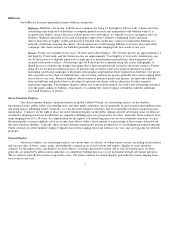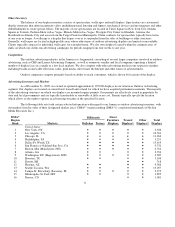iHeartMedia 2009 Annual Report Download - page 20
Download and view the complete annual report
Please find page 20 of the 2009 iHeartMedia annual report below. You can navigate through the pages in the report by either clicking on the pages listed below, or by using the keyword search tool below to find specific information within the annual report.
Other important outdoor advertising regulations include the Intermodal Surface Transportation Efficiency Act of 1991
(currently known as SAFETEA-LU), the Bonus Act/Bonus Program, the 1995 Scenic Byways Amendment and various increases or
implementations of property taxes, billboard taxes and permit fees. From time to time, legislation has been introduced in both the
United States and foreign jurisdictions attempting to impose taxes on revenue from outdoor advertising. Several state and local
j
urisdictions have already imposed such taxes as a percentage of our outdoor advertising revenue in that jurisdiction. While these
taxes have not had a material impact on our business and financial results to date, we expect state and local governments to continue
to try to impose such taxes as a way of increasing revenue.
We have introduced and intend to expand the deployment of digital billboards that display static digital advertising copy
from various advertisers that change up to several times per minute. We have encountered some existing regulations that restrict or
prohibit these types of digital displays. However, since digital technology for changing static copy has only recently been developed
and introduced into the market on a large scale, existing regulations that currently do not apply to digital technology by their terms
could be revised to impose greater restrictions. These regulations may impose greater restrictions on digital billboards due to alleged
concerns over aesthetics or driver safety.
International regulations have a significant impact on the outdoor advertising industry and our business. International
regulation of the outdoor advertising industry can vary by municipality, region and country, but generally limits the size, placement,
nature and density of out-of-home displays. Other regulations may limit the subject matter and language of out-of-home displays.
ITEM 1A. Risk Factors
Risks Related to Our Business
We may be adversely affected by a general deterioration in economic conditions
The risks associated with our businesses become more acute in periods of a slowing economy or recession, which may be
accompanied by a decrease in advertising. Expenditures by advertisers tend to be cyclical, reflecting overall economic conditions and
budgeting and buying patterns. The global economic downturn resulted in a decline in advertising and marketing by our customers,
resulting in a decline in advertising revenues across our businesses. This reduction in advertising revenues has had an adverse effect
on our revenue, profit margins, cash flow and liquidity. The continuation of the global economic downturn may continue to adversely
impact our revenue, profit margins, cash flow and liquidity.
Primarily as a result of the global economic downturn, our consolidated revenue decreased $1.14 billion during 2009
compared to 2008. Revenue declined $557.5 million during 2009 compared to 2008 from our radio business associated with decreases
in both local and national advertising. Our Americas outdoor revenue declined $192.1 million attributable to decreases in poster and
bulletin revenues associated with cancellations and non-renewals from major national advertisers. Our International outdoor revenue
also declined $399.2 million primarily as a result of challenging advertising markets and the negative impact of foreign exchange.
Additionally, we performed an interim impairment test in the fourth quarter of 2008, and again in the second quarter of
2009, on our indefinite-lived assets and goodwill and recorded non-cash impairment charges of $5.3 billion and $4.0 billion,
respectively. While we believe we have made reasonable estimates and utilized appropriate assumptions to calculate the fair value of
our licenses, billboard permits and reporting units, it is possible a material change could occur. If future results are not consistent with
our assumptions and estimates, we may be exposed to further impairment charges in the future.
Our restructuring program may not be entirely successful
In the fourth quarter of 2008, CCMH commenced a restructuring program targeting a reduction in fixed costs through
renegotiations of lease agreements, workforce reductions, the elimination of overlapping functions and other cost savings initiatives.
The program has resulted in restructuring and other expenses, and we may incur additional costs pursuant to the restructuring program
in the future. No assurance can be given that the restructuring program will achieve the anticipated cost savings in the timeframe
expected or at all, or for how long any cost savings will persist. In addition, the restructuring program may be modified or terminated
in response to economic conditions or otherwise.
17
























